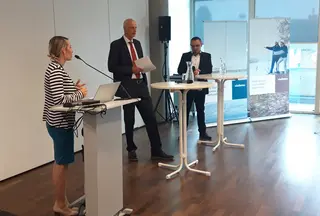In international freight transport, nothing goes without the container. On the Danube, however, they are rarely seen. Although empty container transports have been running steadily for several years. Not to forget, there are large volumes of continental transports in swap bodies and semi-trailers, which could also be transported in an environmentally friendly way by barge. How the volume of intermodal units on the Danube can be increased was discussed at the first hybrid expert workshop with a total of almost 50 guests. Some of them were connected online and some were present on site.
Thinking INSIDE the box. How exactly container transports by inland vessel can work on the Danube was discussed at an expert workshop, which was held at Tech Gate Vienna on September 29, 2021. But not all participants were attending physically in the room, because for the first time, the audience could choose to participate in person or virtually. Special attention was paid to the constant exchange between the digital and the in-person audience during the workshop via webcam & co.
First Hans-Peter Hasenbichler, Managing Director of viadonau, highlighted the advantages of Danube navigation and its good environmental performance, as well as the development of initiatives in the field of Danube logistics at viadonau. Afterwards, Bettina Matzner gave a short overview of the special field of container transport via Danube and current challenges and potentials. The Austrian Federal Ministry for Climate Protection also attaches great importance to the topic of "combined transport" within the Austrian transport policy. Julia Elsinger presented national strategies and funding in this area.
Digitally connected from Salzburg, Otto Hawlicek from Container Terminal Enns gave an insight into the multimodal terminal on the Danube in the Ennshafen. Efficient handling of containers by gantry cranes, which span the depots as well as railway tracks and quay, enables the optimal transhipment of containers with increasing quantities every year between the three modes. Currently, about a quarter of the empty containers are delivered to the Ennshafen by barge. In addition to these transports, Mr. Hawlicek also sees potential for continental volumes in swap bodies and semi-trailers by barge.
Not far away, intermodal transports are also moving into the spotlight in Bavaria. Andreas Plank of Bayernhafen reported on the planned expansion in Regensburg and the implementing of the new container terminal in Passau in cooperation with various partners.
Multinaut Donaulogistik has also gained experience with container transports by barge in the past. Chartering a total of 20 vessels, numerous products are transported along the Rhine-Main-Danube corridor. As Valdet Farizi highlighted, suitable vessels and necessary experience are already available. In order to ensure reliability despite lock closures in the westbound direction, currently potentials for cooperation with railways are worked out.
At Nothegger Transport Logistik, on the other hand, the focus is not on ISO containers but on continental volumes. With numerous block train connections through Western Europe, Karl Nothegger Senior has already been able to establish many intermodal transports. Currently, the possibility of inland waterway transports to the east is being investigated in a joint project with various partners; the conception of an optimized vessel is also part of this project.
The following discussion showed that in principle there is enough volume available for the transport of full containers. What container transports on the Danube still need for a big push is cooperation: only together can carriers, forwarders, ports and shipping companies get such concepts off the ground. Last but not least, cooperation with rail operators would open up special opportunities to maximise the strengths of both modes of transport and increase resilience.

